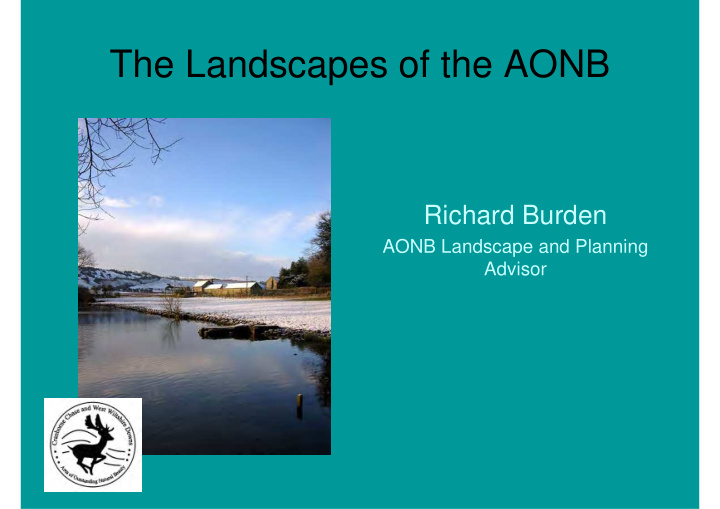



The Landscapes of the AONB Richard Burden AONB Landscape and Planning Advisor
What is Landscape? Landscape is more than just topography and ground cover; it includes the interactions of generations of people who have lived, worked, or visited; the cultural as well as physical attributes; and the living wildlife, the aesthetic, and the productive aspects. Landscapes are more than three dimensional, they change daily and seasonally, they respond to the weather, some have a greater proportion of hard and constructed elements whilst in others the soft and semi-natural predominate.
Why Characterise Landscapes? We need to have LCAs to help us know and understand our landscapes in order to: meet our duties to conserve and enhance them influence sustainable landscape management better design & integrate essential development Comply with PPS7, para 24
Landscape Character Assessments Level Scale Terminology National Broad National [Joint] Overview Character Areas County/ Readily Landscape District/AONB recognisable Character Types - named Landscape Character Areas Locality/Site Detailed Landscape Character Areas, Local Landscape Context
LANDSCAPE CHARACTER TYPES AND AREAS CCWWD AONB: 8 Landscape Types 15 Landscape Areas
Chalk Escarpments: LC Type 1 Arable cultivation is often found on shallower slopes at the foot of the steep wooded scarp face.
Chalk Escarpments: Key Characteristics • Dramatic chalk escarpments eroded into rounded spurs and deep combes. • Underlying geology of Lower, Middle and Upper Chalk giving rise to the predominantly calcareous soils. • Areas of unimproved chalk grassland of international importance on steeper slopes. • Field systems on the lower slopes, including strip lynchets close to medieval villages sited along the springline. • Improved pasture and arable fields occupy the shallower, more accessible, slopes where straight-sided fields represent late 18th/early 19th century Parliamentary inclosure. • Hanging woodland and sunken lanes are features of the steep, enclosing chalk combes. • Panoramic views over adjacent landscapes.
Landscape Character Areas Whilst character types are generic, character areas are specific and have locality names Areas are not sites; they are the context for sites Remember the cultural heritage aspects of landscape as well as the topographic structure, artefacts and living features
Character Descriptions Character descriptions should aim to create ‘mind pictures’, and focus on local distinctiveness and sense of place Descriptions should be structured and ‘value neutral’ It is entirely appropriate to include human emotions and responses to landscapes – but after the objective description and analysis!
Chalk Escarpments: A Melbury to Blandford B West Wiltshire Downs C Fovant and Chalke Ancient strip lynchets create strong landform patterns on the escarpment. The Fovant Badges are key landmark features of the steep slopes. Note the farm on the Greensand Terrace below the slope. Steep slope with sharp transition and scrub developing on ancient permanent grassland
Character Descriptions Key Characteristics Location and Boundaries Summary of Visual Character PHYSICAL INFLUENCES • Geology and Soils • Landform and Hydrology • Land Cover • Ecological Character and Biodiversity
Character Descriptions HUMAN INFLUENCES • Evidence of Past Social Structure • Field Patterns, Boundaries and Predominant Date of Enclosure • Land Use and Recreation • Historic Development of Settlement and Relationship with the Landscape • Settlement and Built Character • Historic Environment EVALUATION • Strength of Character • Current Condition • Past and Present Change • Possible Future Trends • Management Objective
Area1A : MELBURY TO BLANDFORD CHALK ESCARPMENT Key Characteristics • Dramatic chalk escarpment on the western edge of the AONB with rounded spurs and deep combes. • Underlying geology of Lower, Middle and Upper Chalk giving rise to the predominantly calcareous soils. • Areas of unimproved chalk grassland of international importance on steeper slopes interspersed with broken areas of scrub. • Arable crop production and improved pasture on the shallower slopes. • Hanging woodland and sunken lanes are features of the steep, enclosing chalk combes.
Area1A : MELBURY TO BLANDFORD CHALK ESCARPMENT Key Characteristics • Beech copses, Scot’s pine and hanging woodland enhance the sense of woodedness, increase enclosure and act as focal points. • Elevated and uninterrupted landform, provides panoramic views over adjacent landscapes. • Round barrows and cross-ridge dykes along the escarpment edge. • Field systems on the lower slopes, including strip lynchets close to medieval villages sited along the springline. • Straight-sided fields represent late 18th/early 19th century Parliamentary enclosure.
Open Chalk Downlands: Areas: West Wiltshire Downs Southern Downland Belt
Downland Hills: Area: Martin – Whitsbury Downland Hills
Cranborne Chase Wooded Chalk Downland: Area:
Chalk River Valleys Areas: Wylye Chalk River Valley Ebble Chalk River Valley Stour & Avon Tributary Valleys
Greensand Terrace Areas: Fovant Greensand Terrace Kilmington Greensand Terrace
Greensand Hills Areas: Donhead – Fovant Hills Penselwood – Longleat Hills
Area: Vale of Wardour Rolling Clay Vales
Recommend
More recommend